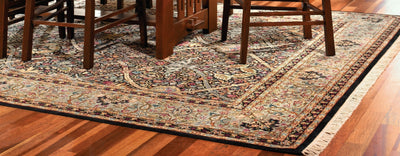
More than Mission: Stickley’s Wide-Ranging Styles
Share
 Print
Print
[originally posted August 2021]
For many Americans, the Stickley name is synonymous with Mission furniture, and rightly so. But for much of its history, the styles that kept L. & J.G. Stickley in business were its non-Mission styles. Even today, while Mission remains the brand’s beloved foundation, there is so much more to Stickley style than many customers realize, from its traditional beginnings to today’s thoroughly modern looks.
Cherry Valley
This blog has previously touched on Leopold Stickley’s decision to move on from Mission after its popularity had waned by around 1920. He successfully gauged the public’s desire for a more traditional colonial style and was inspired by the early artisans of English, Dutch, and German descent who honed their craft in the northeastern United States. He traveled the region widely, collecting antiques that reflected their work, and he launched his Early American furniture in the 1930s. In the 1940s this was renamed the Cherry Valley Collection (after the stretch of Eastern and Central New York where many of those artisans lived and worked), and it was embraced across the nation, in city and country.


Cherry Valley furniture (The Stickley Museum) Cherry Valley catalog cover
Colonial Williamsburg
Cherry Valley was Stickley’s preeminent line for decades. After Alfred and Aminy Audi bought the company in 1974, they slowly began to expand its Colonial Revival offerings to include styles specific to Boston, Philadelphia, and other urban centers. With the help of experienced designer William DeBlaay, they introduced more 18th-century pieces in cherry and mahogany, with a variety of fine finishes. In 2000, Stickley signed a licensing agreement with Colonial Williamsburg to produce official reproductions of its priceless collection of antique furnishings. The Bombé Chest-on-Chest, a favorite among our Stickley Museum holdings, was featured on the cover of Furniture Today as an iconic example of the collection’s exquisite design and flawless craftsmanship.


John Widdicomb, Nichols and Stone
The acquisition of two venerated, family-owned brands helped Stickley further expand its portfolio of classic furniture. In 2002, the company purchased the assets of the John Widdicomb Company. Pieces produced under the Widdicomb brand offered customers more ornate, formal looks influenced by French, English, and Italian design.


And in 2008, Stickley acquired the historic, Massachusetts-based company Nichols and Stone. Hundreds of years of history inform the Nichols and Stone design language, and Stickley continues to bring to life its signature dining and occasional furniture, beloved Windsor chairs, and iconic beds.


Modern Collections
Today, Stickley’s product offering is as stylistically varied and dynamic as it has ever been. Our fluency with modern styles has gained particular notice, beginning with Park Slope’s modernized take on Mission and quickly followed by the Walnut Grove Collection. This exuberant sculptural treatment of American black walnut, inspired by mid-century modern and Scandinavian design, has won fans across the country and has been a perennial best seller since its 2019 introduction. In 2020 (coinciding with the company’s 120th anniversary!) came Portfolio120, the launch of a new type of offering. In place of a fully coordinated lifestyle collection, Portfolio120 offers standalone pieces and capsule collections designed for the eclectic-minded buyer. Yet for all their freshness, what makes our modern collections stand apart is the same commitment to honest materials and unparalleled craftsmanship that is Stickley’s hallmark. Modern furniture can also be built to last a lifetime.

Walnut Grove Collection

Portfolio120 Welland Dining


Walnut Grove End Table. Portfolio120 Dearborn Cocktail Table

Sneak Peek: Martine
Stay tuned, because our latest beautiful style is coming soon! The Martine Collection will arrive this winter with a softness you’ll want to reach out and touch. Crafted of solid cherry, Martine’s edges and angles have been smoothed away in favor of soft curves and perfect arcs; a range of warm cherry finishes reflect the muted shimmer of custom-designed Brushed Bronze hardware. It’s a look that’s calm, friendly, and comforting, and one that’s soon to become a classic Stickley style.
Additional sources:
Mrs. Aminy Audi, CEO and Chair of the Board
American Furniture Hall of Fame, “Oral History Interview with Aminy Audi,” April 14, 2016.
Amanda Clifford, Director, The Stickley Museum











